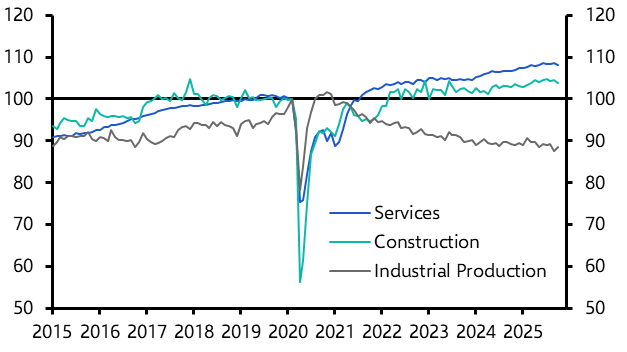Last week we launched a new product: Capital Calls. The idea is to bring together our highest conviction macro calls and, crucially, flesh out their market implications. These will be included as part of our service to all clients and will be continuously refreshed and updated.
I don’t intend to repeat everything that is in Capital Calls here but, in the spirit of the many end-of-year notes that are being written right now, it’s worth considering what are likely to be the key macro drivers of markets in 2021. The first point to make is that the experience of the past 12 months should give all forecasters pause for thought. I’m willing to bet that this time last year nobody (including us) was forecasting that a pandemic would rip through the world in 2020, causing the biggest fall in global GDP since World War Two. What’s more, I’m willing to bet that anybody that did forecast such an event, failed also to forecast that stock markets would end the year at a record high. As I’ve noted before, the pandemic is a useful reminder of Keynes’ principle of fundamental uncertainty – some things are simply unknowable before they happen.
In such circumstances, the key is to respond to events as they unfold, isolate what does and does not matter and identify the factors that will shape what comes next. On that front, I would give us credit for anticipating the scale of the global downturn once the spread of the virus became apparent, and for arguing that, despite the huge economic damage caused by the pandemic, fiscal and monetary stimulus would ease financial market dislocation and eventually drive the price of risky assets higher.
I suspect that the three big macro themes of 2021 will be recovery, catch-up and accommodation.
The first speaks for itself. Developments over the past month have prompted us to assume within our forecasts that vaccines are distributed on a sufficient scale to quash the virus in most developed economies and therefore remove the need for widespread restrictions on activity. The result is likely to be a significant recovery in global GDP.
The scale of the shock caused by the pandemic may make the usual GDP data misleading: 2021 is likely to see one of the fastest rates of global GDP growth on record, but this needs to be viewed in the context of the huge slump in GDP this year. The correct way to intercept the recovery is to focus on levels of output. We now expect that global GDP will return to its pre-virus level by mid-2021. And while it will remain below its pre-virus trend for longer, we expect that gap to be closed by around 2024. That makes us more optimistic than the consensus on both the near- and long-term global outlook.
The second theme is likely to be one of catch-up. Some economies (notably Spain, India, France and the UK) have been hit particularly hard by the pandemic and remain depressed. Others (notably China) have already rebounded. The result is that the virus has produced a wide variation in economic outcomes. These divergences won’t disappear in 2021, but they are likely to narrow as vaccines are rolled out and the hardest hit economies start to find their feet.
The final theme of 2021 is likely to be continued accommodation, in particular by the world’s major central banks. The outlook for next year has brightened but most countries face a difficult winter and economies will remain dependent on continued policy support. Indeed, one of the biggest risks to the outlook is that governments pull the rug from under the feet of the recovery by removing fiscal support too quickly. All of this points to monetary policy having to remain extremely accommodative. While we’re more bullish than most forecasters on growth, we remain of the view that the world’s major central banks will continue to maintain ultra-loose monetary conditions and that real rates remain firmly in negative territory.
All of this will have important consequences for financial markets. The prospect of continued monetary accommodation should keep a lid on bond yields which, against the backdrop of economic recovery, should mean a generally positive environment for risky assets. But the interesting calls lie in the differences between markets. Inflation-linked bonds should outperform in the US, but it’s a different story in the euro-zone; the dollar is likely to weaken against other G10 currencies, but particularly so against high-beta ones like the Aussie dollar; and while local currency government bond yields in most EMs should fall, watch out for idiosyncratic policies such as the introduction of yield caps in Korea.
We’ll continue to update Capital Calls to reflect our strongest views on how we expect asset prices to change based on our economic analysis. In the meantime, this my last note of what’s been a difficult, but endlessly interesting, year. Thanks for reading – I wish you all a happy and restful end to 2020.
In case you missed it:
- Our Chief Commodities Economist, Caroline Bain, takes stock of last week’s OPEC+ meeting and finds downside risks to our oil price price forecasts.
- Keynes’s General Theory meets Denmark’s Minkgate in our latest Nordics & Swiss Weekly.
- Our Senior EM Economist, Edward Glossop, argues that vaccines have reduced but not eliminated financial risks in emerging economies.



